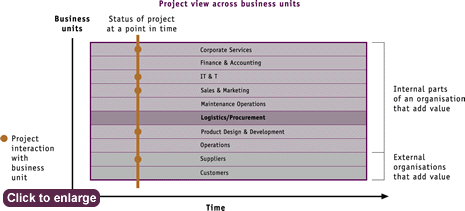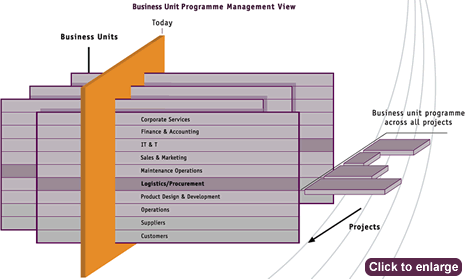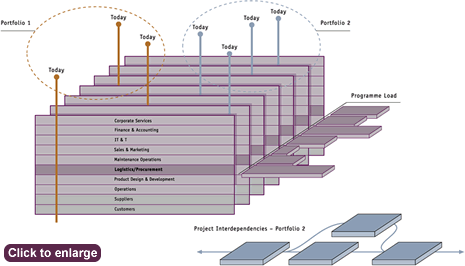The multi-dimensional nature of projects, programmes and portfolios
Caravel’s approach can be readily applied in context of the Value Chain Analysis which also serves to incorporate the dimension of time as an integral element within the model.
The Value Chain Analysis is based on the premise that each organisational process adds value and is part of a Value Chain.
Our model specifies all processes that relate to your organisation as well as your customers and suppliers – these processes are displayed as business units (e.g. sales & marketing, logistics/procurement, operations)
The project view
Projects interact with these business units at various points throughout the project lifecycle, while the project lifecycle itself proceeds along the horizontal time axis.

The project lifecycle proceeds along the horizontal time axis, during which time the project interacts with different internal and external business units.
The programme view
The view from a business unit programme perspective shows several project sections. These projects involve different business units (functional areas) where the workload is managed as a programme. The current view at any point in time depicts the load on resources within any given business unit.

The Business Unit Programme perspective depicts that projects are at a different stage of the project lifecycle while producing different loads on resources within the given business units.
The portfolio view
Our multi-dimensional modeling offers valuable knowledge about the inter-relationships between projects.
It clearly identifies the network of project interdependencies for planning and reporting purposes.
The portfolio may have its own business objectives or derive them from its individual projects.
For example, a portfolio may comprise a group of projects to deliver a new management system using new IT architecture. The projects to design and install the new hardware will have specific objectives and utilise different resources from the projects that develop and implement new management systems. However, the projects have clear and direct dependencies. There is no point in developing one set of projects if the other set of projects won’t proceed, and vice versa.
The objective of the portfolio is the deployment of the fully functioning management system.

The portfolio view identifies project interdependencies between different sets of projects. For instance, both sets of projects may need to be delivered so the portfolio achieves its overall objective.
The P3MO™ model also supports the notion of minimum project group sets, i.e. groups of projects that need to be executed for the organisation to derive a core strategic advantage. Conventional concepts do not adequately cater for this requirement.
|